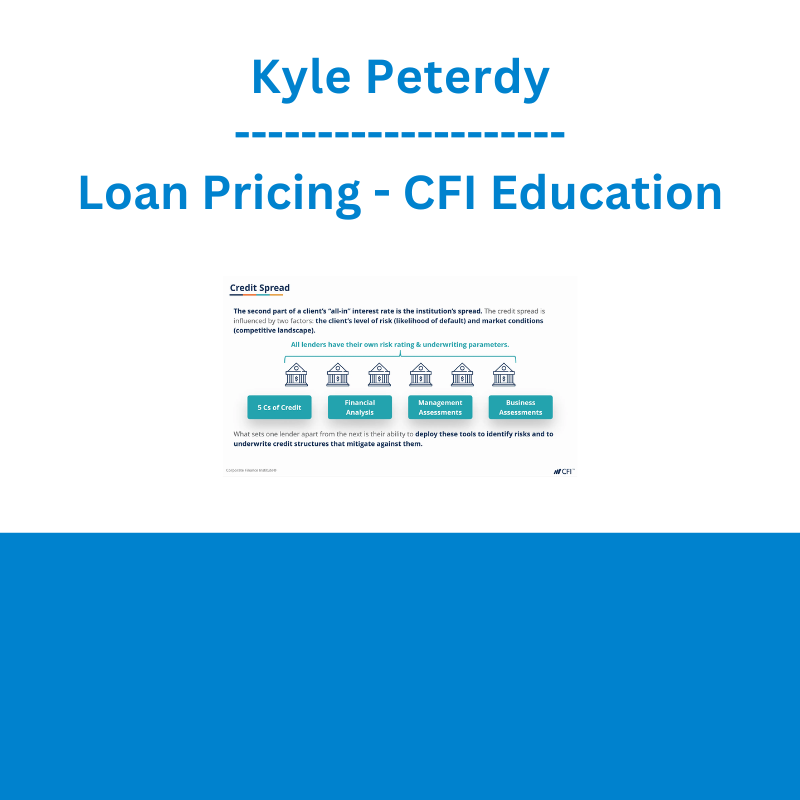*** Proof of Product ***
Exploring the Essential Features of “Kyle Peterdy – Loan Pricing – CFI Education”
Loan Pricing
Become fluent in the language of lending to small and medium-sized enterprises by deconstructing the key components of a risk rating and loan pricing model
- Explain debt as a funding source and how the capital stack works
- Explore loss-given default (LGD) and risk-adjusted return on capital (RAROC)
- Calculate a client risk rating and prepare a pricing proposal
Overview
Loan Pricing Course Overview
This Loan Pricing course looks at the fundamentals and factors banks consider when pricing a loan. We will examine how interest rates, loan structures, and different characteristics of a loan can affect the loan’s pricing. This Loan Pricing course will also explore how a bank earns revenue and what affects its profitability. This course will include an interactive case study that shows you a practical demonstration using a risk rating and profitability model in Excel. We will also cover different levers that a credit analyst can use during client negotiations and how they can affect the pricing and profitability of a loan.
Loan Pricing Learning Objectives
Upon completing this course, you will be able to:
- Explain debt as a funding source, its pros, and its cons
- Identify loan types and their relative degree of profitability
- Define risk-adjusted return, and risk-adjusted return on capital
- Calculate and interpret an example risk rating
- Recommend pricing structures based on risk rating and loan type
Who should take this course?
This Loan Pricing course is designed for current and aspiring Commercial Banking and lending professionals, including Relationship Managers, Credit Analysts, and Risk Management professionals seeking a more comprehensive understanding of loan pricing and profitability. This course provides a real-world perspective and a hands-on case study outlining how a financial institution would evaluate a client’s default risk and how they might structure borrowing accordingly to optimize risk-adjusted return on capital. The practical exercises, case study, and tools explored in this course will be useful for any credit professional or financial analyst that wishes to work in private lending, business banking, commercial banking, or corporate banking.
What you’ll learn
Introduction
Course Objectives
Downloadable Files
Debt as a Funding Source
Capital Structure
Debt vs. Equity
Secured vs. Unsecured Loans
Debt Repayment Profile
Capital Stack
Acquisition Financing Structure Example
Banking Spectrum
Interactive Exercise 1
Revenue & Profitability
Interest Rates, Treasury Yields, and Fed Funds Rates
Credit Ratings and Agencies
Net Interest Income
Cost of Funds
Credit Spread
Loss Given Default
Risk-Adjusted Return
Risk-Adjusted Return on Capital
Risk-Adjusted Return Example
Financial Institutions vs. Private Lenders
Interactive Exercise 2
Pricing, Structure, & Execution
Balance Sheet Lending vs. Securitization
Fixed Rates vs. Floating Rates
Term Financing vs. Operating Credit
Committed vs. Uncommitted
Pricing Exceptions
Client Negotiations
Interactive Exercise 3
Risk Rating & Profitability Model
Risk Rating and Profitability Model – Client Introduction
Introduction to Risk Rating Model
Income Statement
Balance Sheet
Debt Input Schedule
Risk Rating and Profitability
RAROC Scenario Analysis
Download Completed Model
Conclusion
Conclusion
Qualified Assessments
Qualified Assessment
Please see the full list of alternative group-buy courses available here: https://lunacourse.com/shop/









